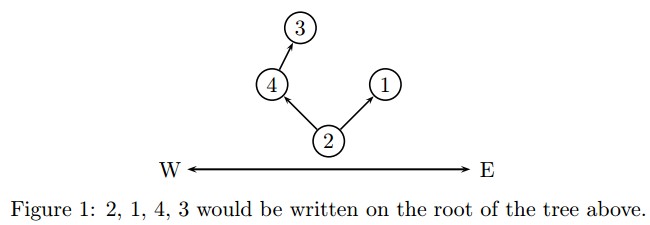题目链接:http://acm.hdu.edu.cn/showproblem.php?pid=5444
Elven Postman
Time Limit: 1500/1000 MS (Java/Others) Memory Limit: 131072/131072 K (Java/Others)
Total Submission(s): 1206 Accepted Submission(s): 681
Problem Description
Elves are very peculiar creatures. As we all know, they can live for a very long time and their magical prowess are not something to be taken lightly. Also, they live on trees. However, there is something about them you may not know.
Although delivering stuffs through magical teleportation is extremely convenient (much like emails). They still sometimes prefer other more “traditional” methods.
So, as a elven postman, it is crucial to understand how to deliver the mail to the correct room of the tree. The elven tree always branches into no more than two paths upon intersection, either in the east direction or the west. It coincidentally looks awfully like a binary tree we human computer scientist know. Not only that, when numbering the rooms, they always number the room number from the east-most position to the west. For rooms in the east are usually more preferable and more expensive due to they having the privilege to see the sunrise, which matters a lot in elven culture.
Anyways, the elves usually wrote down all the rooms in a sequence at the root of the tree so that the postman may know how to deliver the mail. The sequence is written as follows, it will go straight to visit the east-most room and write down every room it encountered along the way. After the first room is reached, it will then go to the next unvisited east-most room, writing down every unvisited room on the way as well until all rooms are visited.
Your task is to determine how to reach a certain room given the sequence written on the root.
For instance, the sequence 2, 1, 4, 3 would be written on the root of the following tree.

So, as a elven postman, it is crucial to understand how to deliver the mail to the correct room of the tree. The elven tree always branches into no more than two paths upon intersection, either in the east direction or the west. It coincidentally looks awfully like a binary tree we human computer scientist know. Not only that, when numbering the rooms, they always number the room number from the east-most position to the west. For rooms in the east are usually more preferable and more expensive due to they having the privilege to see the sunrise, which matters a lot in elven culture.
Anyways, the elves usually wrote down all the rooms in a sequence at the root of the tree so that the postman may know how to deliver the mail. The sequence is written as follows, it will go straight to visit the east-most room and write down every room it encountered along the way. After the first room is reached, it will then go to the next unvisited east-most room, writing down every unvisited room on the way as well until all rooms are visited.
Your task is to determine how to reach a certain room given the sequence written on the root.
For instance, the sequence 2, 1, 4, 3 would be written on the root of the following tree.

Input
First you are given an integer
T(T≤10)![]()
indicating the number of test cases.
For each test case, there is a numbern(n≤1000)![]()
on a line representing the number of rooms in this tree.
n![]()
integers representing the sequence written at the root follow, respectively
a![]() 1
1![]() ,...,a
,...,a![]() n
n![]()
![]()
where a![]() 1
1![]() ,...,a
,...,a![]() n
n![]() ∈{1,...,n}
∈{1,...,n}![]()
.
On the next line, there is a numberq![]()
representing the number of mails to be sent. After that, there will be
q![]()
integers x![]() 1
1![]() ,...,x
,...,x![]() q
q![]()
![]()
indicating the destination room number of each mail.
For each test case, there is a number
On the next line, there is a number
Output
For each query, output a sequence of move (E![]()
or W![]()
)
the postman needs to make to deliver the mail. For that
E![]()
means that the postman should move up the eastern branch and
W![]()
the western one. If the destination is on the root, just output a blank line would suffice.
Note that for simplicity, we assume the postman always starts from the root regardless of the room he had just visited.
Note that for simplicity, we assume the postman always starts from the root regardless of the room he had just visited.
Sample Input
2 4 2 1 4 3 3 1 2 3 6 6 5 4 3 2 1 1 1
Sample Output
E WE EEEEE
Source
Recommend
题目大意:给n个结点,第一个输入的为给一个根节点,接下的一些结点比根节点小就挂在左边,比根节点大就挂在根节点的右边。以此类推。
。。。
给出q个询问。询问每一个从根节点出发到某个点的路径。
解题思路:一个点一个点的加进去就好了。和根节点进行比較,最后遍历二叉树查找就可以。
详见代码。
#include <iostream>
#include <cstdio>
using namespace std;
struct node
{
int data;
node *leftchild,*rightchild;
node (int st)
{
data=st;
leftchild=rightchild=NULL;
}
};
void creat(node *root,int num)
{
if (root->data>num)
{
if (root->leftchild==NULL)
{
node *n=new node(num);
root->leftchild=n;
}
else
{
creat(root->leftchild,num);
}
}
else
{
if (root->rightchild==NULL)
{
node *n=new node(num);
root->rightchild=n;
}
else
{
creat(root->rightchild,num);
}
}
}
void get_path(node *root,int x)
{
if (root->data==x)
{
puts("");
return ;
}
else if (root->data>x)
{
putchar('E');
get_path(root->leftchild,x);
}
else
{
putchar('W');
get_path(root->rightchild,x);
}
}
int main()
{
int t;
int a;
scanf("%d",&t);
while (t--)
{
int n;
scanf("%d",&n);
int st;
scanf("%d",&st);
node *root=new node(st);
for (int i=1;i<n;i++)
{
scanf("%d",&a);
creat(root,a);
}
int q,qq;
scanf("%d",&q);
for (int i=0;i<q;i++)
{
scanf("%d",&qq);
get_path(root,qq);
}
}
return 0;
}